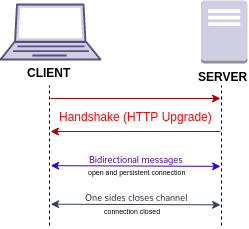
The Hypertext Transfer Protocol (HTTP) is an application layer protocol in the Internet protocol suite model for distributed, collaborative, hypermedia information systems. HTTP is the foundation of data communication for the World Wide Web, where hypertext documents include hyperlinks to other resources that the user can easily access, for example by a mouse click or by tapping the screen in a web browser.
The Real-Time Streaming Protocol (RTSP) is an application-level network protocol designed for multiplexing and packetizing multimedia transport streams over a suitable transport protocol. RTSP is used in entertainment and communications systems to control streaming media servers. The protocol is used for establishing and controlling media sessions between endpoints. Clients of media servers issue commands such as play, record and pause, to facilitate real-time control of the media streaming from the server to a client or from a client to the server.
The File Transfer Protocol (FTP) is a standard communication protocol used for the transfer of computer files from a server to a client on a computer network. FTP is built on a client–server model architecture using separate control and data connections between the client and the server. FTP users may authenticate themselves with a plain-text sign-in protocol, normally in the form of a username and password, but can connect anonymously if the server is configured to allow it. For secure transmission that protects the username and password, and encrypts the content, FTP is often secured with SSL/TLS (FTPS) or replaced with SSH File Transfer Protocol (SFTP).

Extensible Messaging and Presence Protocol is an open communication protocol designed for instant messaging (IM), presence information, and contact list maintenance. Based on XML, it enables the near-real-time exchange of structured data between two or more network entities. Designed to be extensible, the protocol offers a multitude of applications beyond traditional IM in the broader realm of message-oriented middleware, including signalling for VoIP, video, file transfer, gaming and other uses.
Message-oriented middleware (MOM) is software or hardware infrastructure supporting sending and receiving messages between distributed systems. MOM allows application modules to be distributed over heterogeneous platforms and reduces the complexity of developing applications that span multiple operating systems and network protocols. The middleware creates a distributed communications layer that insulates the application developer from the details of the various operating systems and network interfaces. APIs that extend across diverse platforms and networks are typically provided by MOM.
The following is a comparison of instant messaging protocols. It contains basic general information about the protocols.
Push technology, also known as server push, refers to a method of communication on the Internet where the initial request for a transaction is initiated by the server, rather than the client. This approach is different from the more commonly known "pull" method, where information transmission is requested by the receiver or client.
Real-Time Messaging Protocol (RTMP) is a communication protocol for streaming audio, video, and data over the Internet. Originally developed as a proprietary protocol by Macromedia for streaming between Flash Player and the Flash Communication Server, Adobe has released an incomplete version of the specification of the protocol for public use.
Comet is a web application model in which a long-held HTTPS request allows a web server to push data to a browser, without the browser explicitly requesting it. Comet is an umbrella term, encompassing multiple techniques for achieving this interaction. All these methods rely on features included by default in browsers, such as JavaScript, rather than on non-default plugins. The Comet approach differs from the original model of the web, in which a browser requests a complete web page at a time.
.NET Remoting is a Microsoft application programming interface (API) for interprocess communication released in 2002 with the 1.0 version of .NET Framework. It is one in a series of Microsoft technologies that began in 1990 with the first version of Object Linking and Embedding (OLE) for 16-bit Windows. Intermediate steps in the development of these technologies were Component Object Model (COM) released in 1993 and updated in 1995 as COM-95, Distributed Component Object Model (DCOM), released in 1997, and COM+ with its Microsoft Transaction Server (MTS), released in 2000. It is now superseded by Windows Communication Foundation (WCF), which is part of the .NET Framework 3.0.

Jingle is an extension to XMPP which adds peer-to-peer (P2P) session control (signaling) for multimedia interactions such as in Voice over IP (VoIP) or videoconferencing communications. It was designed by Google and the XMPP Standards Foundation. The multimedia streams are delivered using the Real-time Transport Protocol (RTP). If needed, NAT traversal is assisted using Interactive Connectivity Establishment (ICE).

HTTP persistent connection, also called HTTP keep-alive, or HTTP connection reuse, is the idea of using a single TCP connection to send and receive multiple HTTP requests/responses, as opposed to opening a new connection for every single request/response pair. The newer HTTP/2 protocol uses the same idea and takes it further to allow multiple concurrent requests/responses to be multiplexed over a single connection.

XMPP Standards Foundation (XSF) is the foundation in charge of the standardization of the protocol extensions of XMPP, the open standard of instant messaging and presence of the IETF.
In computer science, request–response or request–reply is one of the basic methods computers use to communicate with each other in a network, in which the first computer sends a request for some data and the second responds to the request. More specifically, it is a message exchange pattern in which a requestor sends a request message to a replier system, which receives and processes the request, ultimately returning a message in response. It is analogous to a telephone call, in which the caller must wait for the recipient to pick up before anything can be discussed. This is a simple but powerful messaging pattern which allows two applications to have a two-way conversation with one another over a channel; it is especially common in client–server architectures.
HTTP tunneling is used to create a network link between two computers in conditions of restricted network connectivity including firewalls, NATs and ACLs, among other restrictions. The tunnel is created by an intermediary called a proxy server which is usually located in a DMZ.

Byte serving is the process introduced in HTTP protocol 1.1 of sending only a portion of a message from a server to a client. Byte serving begins when an HTTP server advertises its willingness to serve partial requests using the Accept-Ranges response header. A client then requests a specific part of a file from the server using the Range request header. If the range is valid, the server sends it to the client with a 206 Partial Content status code and a Content-Range header listing the range sent. If the range is invalid, the server responds with a 416 Requested Range Not Satisfiable status code.

WebSocket is a computer communications protocol, providing simultaneous two-way communication channels over a single Transmission Control Protocol (TCP) connection. The WebSocket protocol was standardized by the IETF as RFC 6455 in 2011. The current specification allowing web applications to use this protocol is known as WebSockets. It is a living standard maintained by the WHATWG and a successor to The WebSocket API from the W3C.
QUIC is a general-purpose transport layer network protocol initially designed by Jim Roskind at Google, implemented, and deployed in 2012, announced publicly in 2013 as experimentation broadened, and described at an IETF meeting. QUIC is used by more than half of all connections from the Chrome web browser to Google's servers. Microsoft Edge, Firefox and Safari support it.
Metronome is a light-weight XMPP server written in Lua based on Prosody. It's aimed to provide advanced features while maintaining a modest resource usage. Extensive PubSub and Microblogging over XMPP support along other extensions including: Stream Management, CSI, full support of Bidirectional S2S Streams (BIDI), MAM, Push Notifications, Security Labels, Direct TLS support for C2S/S2S.

Xabber is a XMPP client for the Android Operating System. It is developed as an open source Project on GitHub and is licensed under the GNU GPL v.3 license. The original developers are from a software company called Redsolution, Inc. Xabber is available on the Android Play Store and on F-Droid.




